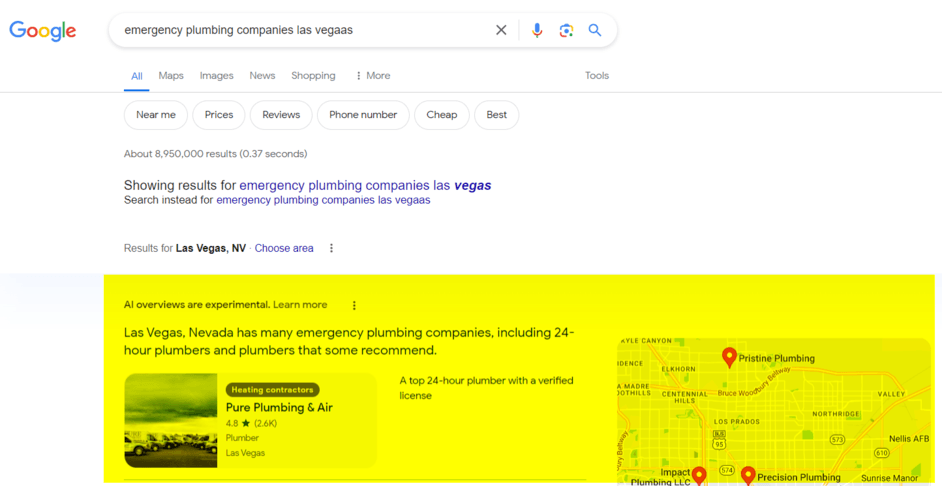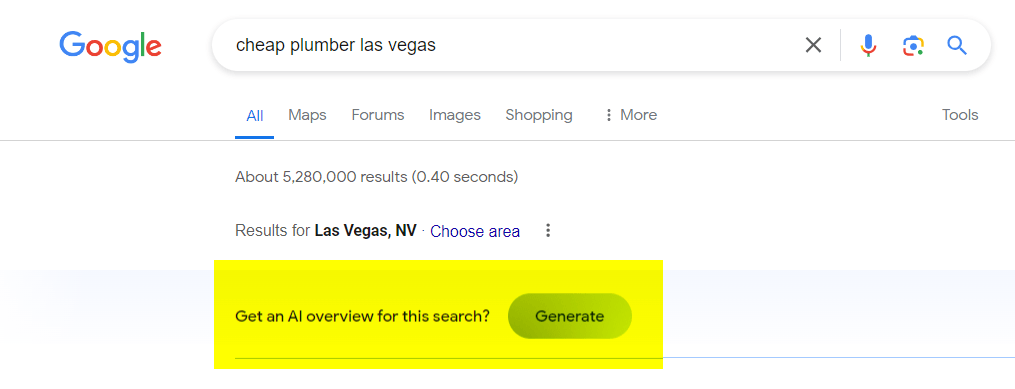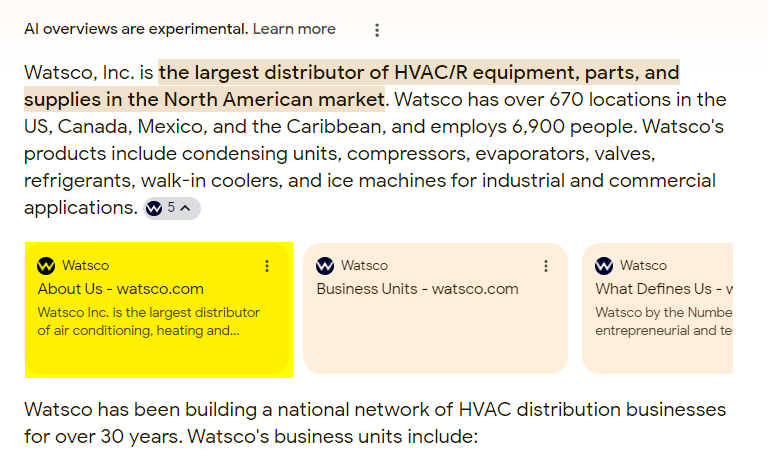-
 Published: Jun 3, 2024
Published: Jun 3, 2024
-
 7 min. read
7 min. read
-
 Sarah Berry
Sarah Berry Lead Web Marketing Consultant
Lead Web Marketing Consultant
- Sarah Berry is a Lead Web Marketing Consultant at WebFX. With more than 10,000 hours of experience, she offers practical insights and strategies you can use to grow your digital revenue. When she isn’t polishing her Time Magazine Person of the Year Award, she’s spending time with her flock of ducks.
With more than 90% of people discovering local businesses online, it’s no wonder companies want to know how Google’s AI Overviews (formerly Search Generative Experience or SGE) will affect local search results. Based on initial research, AI Overviews will present an opportunity — versus challenge — to local brands.
Learn how AI Overviews for local search will accelerate visibility (and how to optimize for it) now!
What are AI Overviews?
AI Overviews, also known as Search Generative Experience, uses AI models like Gemini to generate AI-powered snapshots in Google Search to answer the user’s search intent and provide common follow-up questions.

What are AI Overviews for local search?
According to Google, AI Overviews for local search “provide[s] context about local places, using AI-powered insights that make it easy to compare and explore options.” These insights can include summarizing the business’s capabilities and reviews, as well as showing the company’s location on a map.
How do AI Overviews affect local searches?
AI Overviews affect local searches in a few ways, including the following:
- Visibility: AI Overviews appear above organic search results and below paid ads. Because these snapshots have an average height of 1764 pixels, this setup significantly decreases the visibility of organic search results.
- Functionality: Compared to Google Search, AI Overviews operate as an answer engine vs. a search engine by answering the user’s questions, plus common follow-up questions.
- User journey: According to Google, local searches “often have multiple angles or dimensions to explore.” With AI Overviews, people can explore those angles from within the snapshots, though Google states, “people can explore a wide range of content…on the web” from AI Overviews.
- User adoption: Whether users adopt AI Overviews is the biggest (missing) piece to its impact on local (and non-local) search. According to Google CEO Sundar Pichai, “Our early testing shows that we’ll be able to get [generative AI in search] right.”
While the above factors tremendously influence non-local searches, their impact on local search results is lessened. Why? Snapshots for local searches are almost identical to local 3-packs, which means they rarely generate.

How do AI Overviews affect local SEO?
Because AI Overviews affect local searches, they will affect local search engine optimization (SEO). For example, companies might see a decrease in organic search traffic, which could affect key business metrics, like phone calls, in-store visits and sales, and online lead generation.
As a result, companies will have to reset benchmarks and expectations for local SEO efforts.
You can reset performance benchmarks through a traffic impact assessment, which will evaluate which keywords are most likely to generate fewer site visits because of snapshots and whether your business appears in those snapshots.
It’s worth mentioning that AI Overviews’ impact on local search is significantly less than traditional search.
Should I optimize for location-based snapshots?
Yes.
Even though location-based snapshots require users to take action to generate them, AI Overviews is still an evolving Google Search feature and its snapshots could change to offer unique value to local searches.
Plus, appearing in these snapshots (no matter how little or how much users generate them) gives your company additional visibility in Google Search, both in and outside AI Overviews.
How to optimize for location-based snapshots
Learn how to optimize for location-based snapshots with the tips below:
1. Continue local SEO
Businesses that appear in snapshots practice local search engine optimization. So, don’t stop investing in local SEO strategies, like claiming local listings, building on-site location content, and growing online reviews.
If you practice traditional search engine optimization, continue investing there, too. Sites with a strong SEO program are the ones that most often rank in these snapshots, so it’s critical to maintain SEO efforts.
When discussing AI Overviews and their effect on existing performance benchmarks, remember to explain the importance of traditional and local SEO in maximizing potential organic traffic. Otherwise, leadership can miss that SEO is still valuable — and critical — to business growth.
2. Claim local listings
While a part of local search engine optimization, it’s worth mentioning the value of claiming local listings as a part of optimizing for local AI Overview results. That’s because most location-based snapshots display a carousel similar to the local 3-pack.
You can claim several local listings, including:
- Google Business Profile
- Apple Maps
- Bing Places
Optimize these local listings with as much relevant information as possible, including:
- Name
- Address
- Phone number
- Business hours
- Products or services
This information helps Google understand your business and its capabilities, like whether it provides 24H service, which is critical to featuring in a long-tail search result, like “24 hour emergency plumber near me.”
Your Google Business Profile local listing also plays a vital role when it comes to ranking in AI Mode. Google’s AI Mode uses your Google Business Profile data when generating responses, as well as links to your profile in responses!
Keep your listings updated, too — local listing management software can help!
3. Earn a Google Knowledge Panel
Google Knowledge Graph is one of the databases (Google Shopping Graph is another) that AI Overviews reference when generating snapshots. Getting a Google Knowledge Panel is the avenue to entering Google Knowledge Graph, which contains information on:
- People
- Places
- Things
Acquiring a Google Knowledge Panel takes time because it requires Google to recognize your business as an entity. Some common strategies include creating an “About Us” page (which is also helpful for snapshots), building a reputable backlink profile, and using Organization markup.

4. Optimize Google Business Profile
Google Business Profile is one of the most critical pieces of local optimization. That’s because most location-based snapshots use (and link to) Google Business Profiles. So, doing more than the basic local listing optimizations is important.
For example, consider also:
- Adding images of your location, team, and work
- Uploading common questions and answers
- Creating a Google Posts calendar for holidays, specials, and other announcements
- Selecting relevant Google Business Profile categories
- Providing additional details, like parking availability, holiday hours, and more
You can also consider allowing online appointments or online messaging. If your team can’t support these offerings, that’s okay! Offering them and then not fulfilling them will only create user frustration.
5. Add Products or Services to Google Business Profile
While a type of Google Business Profile optimization, products or services deserve a solo mention because they provide Google with helpful information about your business and its capabilities. This information can then appear in snapshots.
With products or services, you can share:
- Your offerings
- Your prices
- Your availability
Long-tail searches can reference these offers, like “24h emergency plumber for broken toilet.” In the below snapshot, the AI-generated overview mentions information specific to this search, like “can fix toilet issues” and “Dispatches quickly for toilet overflow.”

Notice how the featured images also change to use ones that include toilets vs. other pictures from the business. When uploading product or service images, use an image representative of the service to maximize your appearance in AI Overviews.
6. Use LocalBusiness markup
LocalBusiness markup is another effective optimization for local searches. Markup provides the AI models behind AI Overviews with valuable data about your business, like its name, address, and phone number.
7. Grow online reviews
Online reviews are critical to local SEO and local AI Overview optimization. That’s because most local-based snapshots will use information from reviews, like “Some say the technicians are knowledgeable” or “Some say the technicians are professional.”
Attracting online reviews that provide details about the user’s experience, like whether the team was friendly, timely, and professional, will offer more value for this optimization since those reviews provide context.
When it comes to earning online reviews, consider informing users via:
- Physical materials, like business cards or receipts
- Digital materials, like in an email signature or newsletter
However, do not incentivize reviews for Google Business Profile — it’s against Google’s policies.
Start growing your local AI Overview visibility
Evaluate AI Overviews’ potential impact on your business, and start optimizing for snapshots with the above tips. Or, for professional guidance, consider our Google SGE optimization services. Just contact us online to learn more!
-
 Sarah Berry is a Lead Web Marketing Consultant at WebFX. With more than 10,000 hours of experience, she offers practical insights and strategies you can use to grow your digital revenue. When she isn’t polishing her Time Magazine Person of the Year Award, she’s spending time with her flock of ducks.
Sarah Berry is a Lead Web Marketing Consultant at WebFX. With more than 10,000 hours of experience, she offers practical insights and strategies you can use to grow your digital revenue. When she isn’t polishing her Time Magazine Person of the Year Award, she’s spending time with her flock of ducks. -

WebFX is a full-service marketing agency with 1,100+ client reviews and a 4.9-star rating on Clutch! Find out how our expert team and revenue-accelerating tech can drive results for you! Learn more
Try our free Marketing Calculator
Craft a tailored online marketing strategy! Utilize our free Internet marketing calculator for a custom plan based on your location, reach, timeframe, and budget.
Plan Your Marketing Budget

SEO Success with KOA

Proven Marketing Strategies
Try our free Marketing Calculator
Craft a tailored online marketing strategy! Utilize our free Internet marketing calculator for a custom plan based on your location, reach, timeframe, and budget.
Plan Your Marketing Budget
What to read next





